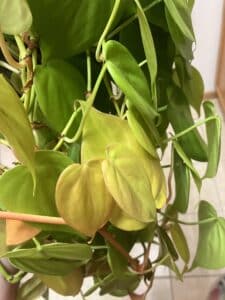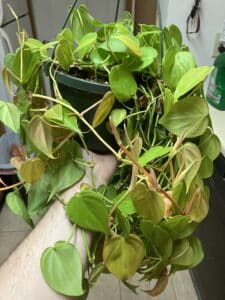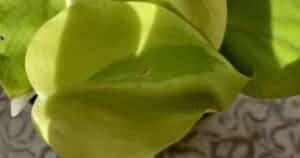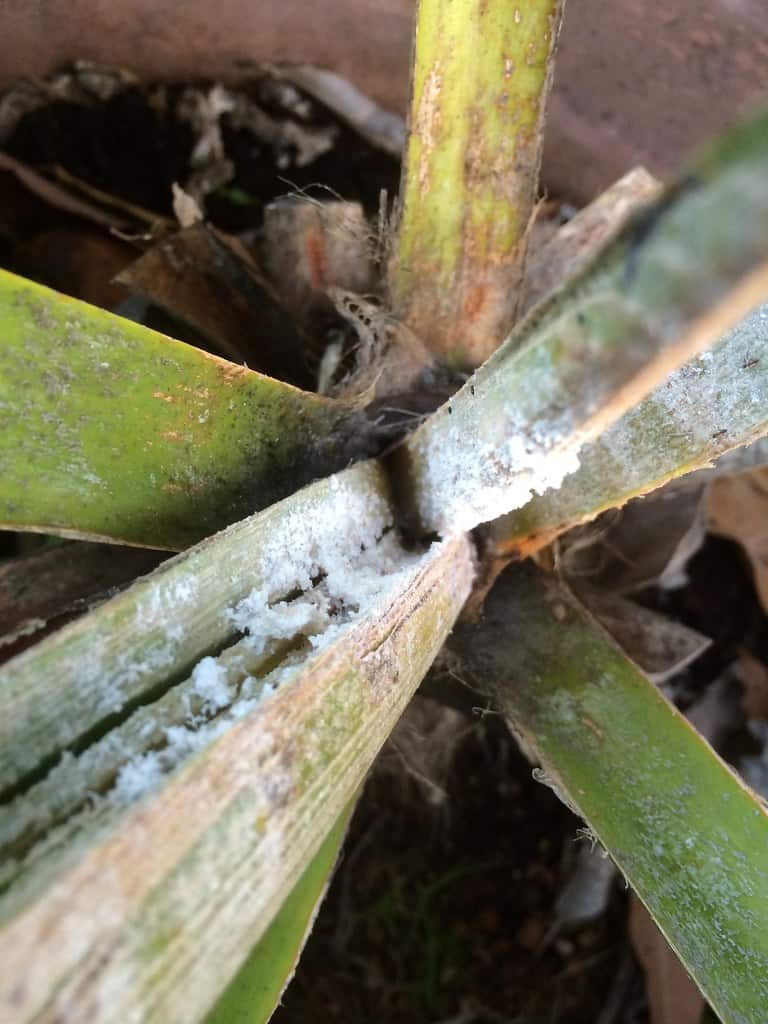Lemon Lime Philodendron vs. Neon Pothos, there have been several debates and confusion regarding these plants over the years.
Both of these have similar appearances, and many people have difficulty differentiating them.
The Neon Pothos ranges up to only 6-10 feet in maximum height, while Lemon Lime Philodendron grows up to 10-15 feet; there is no bloom in Lemon Lime Philodendron, whereas Neon Pothos rarely blooms upon maturity.

You can identify them with their leaves, and there are various ways to identify a Lemon Lime Philodendron or a Neon Pothos.
Through this article, I will be equipping you with an in-depth explanation of how to differentiate between a Lemon Lime Philodendron and a Neon Pothos.
Table of Contents Show
Are Lemon Lime Philodendron and Neon Pothos the Same?
The Lemon Lime Philodendron and Neon Pothos plant species might look similar but differ in many aspects.
These plants originate from different parts of the world and have different habitats.
All species of Philodendron and Pothos belong to the same family of plants called Araceae, known for their bright leaves growing on vines.
They are both houseplants but have entirely different features in terms of leaf size and texture. And the major similarity between the two plants is their heart-shaped leaves.
It is not easy to differentiate these plants just from a quick look since they both look pretty similar physically but are entirely two different plants.
Here are the articles with differences and similarities between some more similar kinds of Pothos such as Marble Queen vs Golden Pothos, Manjula vs Marble Queen Pothos, and Snow Queen vs. Marble Queen Pothos.
Lemon Lime Philodendron vs. Neon Pothos (Confusion Solved!)
Lemon Lime Philodendrons and Neon Pothos have many differences to separate them. Along with the differences, there are also many similarities between them.
Some of the differences include leaf shape, size, growth habits, and the height and structure of the plants.
Here is a summarized table with the major differences between the Lemon Lime Philodendron and Neon Pothos:
| Characteristics | Lemon Lime Philodedndron | Neon Pothos |
|---|---|---|
| USDA Zones | USDA 9-11 | USDA 10-11 |
| Scientific Name | Philodendron Hederaceum Lemon Lime | Epipremnum Aureum |
| Common Name | Tree Philodendron | Neon pothos |
| Origin | South America | Australia |
| Curling of Leaves, Stem | Inward curling | No signs of curling at all |
| Leaf Size | 7-10 inches in length 1-2 inches width | A foot in the wild 4-8 inches indoors |
| Foliage Shape and Color | Bright lime green with light brown, pink tint. | Bright neon green leaves. |
| Flowering Habits | Does not flower. | Requires proper environment to Bloom Flowers upon reaching maturity. |
| Growth Habits | Grows throughout the year. | Grows only during summer. |
| Root growth | Numerous roots per stems. | Single aerial root per stem. |
1. Leaf Shape and Texture
The shape and texture are a good giveaway to easily identify the Lemon Lime Philodendron and Neon Pothos.
Both the Lemon Lime Philodendron and Neon Pothos have heart-shaped leaves, making them quite similar.
But we can differentiate from other factors, such as the Neon Pothos has a bigger and thicker heart-shaped leaf. The leaves of Neon Pothos are also waxy to touch, but you can feel grooves in parts.
While the foliage of the Lemon Lime Philodendron resembles a comparatively more heart-shaped feature, with a slimmer and softer texture than the Neon Pothos.

Another distinctive factor is the direction of the curling of leaves and stems. The stem of Philodendron Lemon Lime is a bit thinner than Neon Pothos.
In the Neon Pothos, petiole connection with the leaf’s base is reasonably straight, making them maintain the position and hence showing no sign of curling.
The Lemon Lime Philodendron tends to curl inwards towards the direction of the plant body.
2. Leaf Size and Color
The size of the plant leaves is also a good parameter from which we can know about two similar plants. The leaves of Lemon Lime Philodendron and Neon Pothos also show some significant differences.
The leaves of Neon Pothos are flat shaped, larger, elongated, and less rounded than Lemon Lime Philodendron. And can extend up to a foot in the wild (4-8 inches indoors).

The Lemon Lime Philodendron has leaves that are more symmetrical, rounded, and broader in shape and grow up to 7-10 inches in length and nearly 1-2 inches in width.
The color of the foliage also acts as a visual guide to help us identify the two plants.
Like its name, the Neon Pothos has bright-colored neon green leaves, which provide it with a tropical look.
While the foliage of the Lemon Lime Philodendron is a bit lighter and tends to look lime green in color, along with a minor brown, pink tint.
3. Flowering Habits
The Flowering Habits of Neon Pothos and Lemon Lime Philodendron is another dead giveaway to differentiate between the two plants.
Neon Pothos is very difficult to flower as it requires a proper environment and light conditions upon reaching maturity to bear any flowers.
As for the case of the Lemon Lime Philodendron, it does not flower at all, even if it is provided with proper conditions.
So, if you are ever confused between a Lemon Lime Philodendron and Neon Pothos, take a look at their flowers to know for sure.
4. Growth Habits
The growth habits of the two plants are quite different. They tend to grow at a different paces and times of the year.
The Lemon Lime Philodendron tends to grow throughout the year and does not slow down its growth during the winter, requiring frequent trimming.
The Neon Pothos often grows very quickly during the summer season and slows down its growth during the winter to conserve its energy.
The root growth of the plants varies from one another, which results in a different overall growth effect.
The Neon Pothos has a thick and single aerial root per node, allowing it to grow properly and separated.
While the Lime Philodendron has various small, thin, and spindly roots on each node, which often grow rapidly and provide more of a jungle effect upon reaching maturity.
Note: Both the Neon Pothos and Lemon Lime Philodendron have a common feature of growing aerial bases and climbing around the walls near it.
5. Height and Structure
The Lemon Lime Philodendron is much bigger than the Neon Pothos.
The Lemon Lime Philodendron tends to grow up to 8-12 inches in height and has tendrils that grow further up to 15 feet from the main plant body.
On the other hand, Neon Pothos is smaller, and the tendrils extend only 6-10 feet from the plant. Even reaching 10 feet takes several years after maturity when the Neon Pothos is grown indoors.
6. Growing Requirements
Neon Pothos grows well in a forest-like lighting setting, which we can imitate by inducing partial lighting conditions. Bright indirect lighting can be maintained by using curtains, window blinds, and covers to block direct sunlight.
Lemon Lime Philodendron prefers 75-80% sunlight exposure throughout the day. It also prefers bright indirect sunlight.
The ideal soil pH for Lemon Lime Philodendron should be slightly acidic, between 6.5-7.5. The ideal soil pH for Neon Pothos should also be slightly acidic, between 6.0-6.5.
But both of these plants can thrive well in slightly acidic to natural conditions. Neon pothos can even survive only on water, but the water needs to be changed frequently.
Pro Tip: You can maintain slightly acidic soil pH by using coffee grounds in the soil mixture.
Take a look at the video for detailed information about the differences between a Neon Pothos and Lemon Lime Philodendron.
Similarities between Lemon Lime Philodendron and Neon Pothos.
Proper lighting, temperature, and humidity levels, proper soil mixture, and watering requirements are a few of the basic parameters similar between Lemon Lime Philodendron and Neon Pothos.
Having similar appearances, these two plants also have similar growth requirements and are easy to maintain.
Here is an overview of the similarities between the two plants.
| Similarities | Similarity Particulars, range. |
|---|---|
| Lighting Requirement | Bright, indirect light for few hours daily. |
| Tempreature | 55-90 degrees Fahrenheit. |
| Humidity | 50% relative humidity |
| Ideal Soil Mixture | Organic materials, nutrients, perlite, charcoal. |
| Watering Requirement | Once a week during summer. Twice a month or once a month during winter. |
| Fertilizer Requirements | Organic materials like peat moss. |
| Common Pests | Mealybugs and Scale insects. |
| Common Diseases | Root rot and fungal infections. |
| Plant Toxicity | Toxic to cats, dogs. |
1. Indirect Lighting
Lemon Lime Philodendron and Neon Pothos are quite similar in lighting requirements. Both plants can tolerate low lighting conditions and often grow normally, even in shaded areas.
The ideal location to place both plants in a location that receives indirect lighting.
Lack of proper lighting for Lemon Lime Philodendron tends to form small and leggy stems flowers. At the same time, Neon Pothos appears dull and shows leggy growth.
Tips to Maintain Ideal Lighting Conditions
- If the plant is placed near windowsills, use window covers drapes that protect the plant from direct sunlight.
- You can also use artificial lights such as LED/GROW lights for optimal growth of the plants.
2. Temperature and Humidity
Both the Lemon Lime Philodendron and Neon Pothos prefer to be placed away from the source of direct heat and cold.
The ideal temperature range for both plants is around 55 to 90 degrees Fahrenheit with a relative humidity level of around 50%.

They also do not prefer drastic changes in temperature fluctuations, leading to stunted growth.
Avoid placing the plants near locations that receive direct breeze, such as near air conditioners, in front of windows, etc.
Like any other plant, the Lemon Lime Philodendron also grows slowly during the winter but has no adverse reactions to a drop in temperature.
If the temperature drops rapidly, the Neon Pothos leaves often turn black and exhibit stunted growth.
Higher temperatures above 75-85 Fahrenheit in Lemon Lime Philodendron can lead to the plant drying out quickly.
In the case of Neon Pothos, a temperature above 85 Fahrenheit induces leaf curling as a response to temperature-related stress.
Tips to Maintain Ideal Temperature and Humidity
- Since temperature and humidity are directly related, it is best to increase humidity around the plant when the temperature is high.
- Avoid placing the plant near windows that receive a direct winter breeze.
- Misting the plant regularly during the daytime helps maintain ideal humidity.
- Putting a wet tray under the pot filled with wet pebbles also helps increase the overall humidity around the plant.
- Using a humidifier is one of the most effective methods of maintaining humidity but is expensive compared to other methods.
- Heating pads can also be used to maintain the ideal temperature for optimal plant growth.
3. Ideal Soil Mixture
Both the Lemon Lime Philodendron and Neon Pothos prefer a similar soil mixture that is loose and well-draining.
The ideal soil mixture for these plants should drain the excess water and require proper aeration, which provides adequate oxygen supply to the roots.
They prefer soil rich in organic materials nutrients and draining materials such as peat, perlite, and charcoal.

The soil mix pH between 6.0-7.0 works for both plants.
You can also create the ideal soil mixture yourself by following this potting mix recipe:
- 1 part houseplant soil
- 1 part peat moss
- Bits and pieces of perlite and charcoal
Mix all these components well and lightly press the soil when placing the plant for even soil compaction.
Lack of proper soil mixture can also lead to various root-related issues such as waterlogging, leading to root rot fungal rot.
Recommended Commercial Potting Mixture for Lemon Lime Philodendron and Neon Pothos:
- Harris Premium Horticultural Perlite for Indoor Plants and Gardening
- FoxFarm Ocean Forest Potting Soil Mix Indoor Outdoor for Garden and Plants
- Miracle-Gro Indoor Potting Mix 6 qt., Grows beautiful Houseplants
4. Watering Requirements
The proper Watering requirement is one of the most basic yet essential factors for healthy plant growth and development.
Both Lemon Lime Philodendron and Neon Pothos prefer relatively moist soil.
Watering these plants once a week during the summer is enough to maintain moist soil for its growth.

The water requirements differ for these plants’ summer and winter months due to their growth requirement. Water these plants only twice a month or even once a month during the winter.
Overwatering the plant can lead to waterlogging of the roots, which can lead to bacterial and fungal infections.
You can also use the dip-stick test for checking whether the plant requires to be watered at the moment.
Dip a wooden stick 2 inches in the soil; if the bottom of the stick comes out dry, then water the plant thoroughly.
Tips to Water Lemon Lime Philodendron vs Neon Pothos Properly
- Only water the plant using room temperature water; avoid hot or cold water as it can cause scalding frost damage.
- Use a soil moisture meter and check the moisture level in the soil and water accordingly.
- Avoid using water that is contaminated with microorganisms or excessive minerals.
- Using distilled water or collected rainwater is best for the plant as it is free of harmful chemicals such as chlorine and calcium oxides prevalent in tap water.
5. Fertilizer Requirements
Proper fertilization is also another important factor that determines the proper growth of the plant.
Since both the Lemon Lime Philodendron and Neon Pothos are not heavy feeders, they do not require constant fertilization.
Using natural organic materials such as peat moss provides proper fertilizing nutrients while maintaining the ideal soil mixture to keep the plant moist.
Also, using a household fertilizer diluted with water every few months enhances the plant’s growth.
Fertilizers need to be diluted with water to avoid the chemical burning of the roots caused by excessive minerals accumulation around the roots.
Using a proper soil mixture is more important for these plants’ growth than using proper fertilizers.
They can grow quite well even in the absence of fertilizers.
Here are some commercial fertilizers which you can use for Lemon Lime Philodendron and Neon Pothos:
- Philodendron Plant Food, Indoor Plant Food Liquid Fertilizer
- Osmocote Smart-Release Plant Food Plus Outdoor & Indoor
- Pothos Fertilizer, Neon Pothos Food
6. Plant Toxicity
In terms of toxicity, both the Lemon Lime Philodendron and Neon Pothos are toxic to cats and dogs. These plants belong to the Araceae family, which is fatally toxic if ingested.
It is best to place the plant away from children and animal reach. It can be placed on high shelves and tabletops.
They contain insoluble calcium oxalates, which can lead to various issues such as oral irritation, burning of the mouth, tongue swelling, vomiting, and difficulty in swallowing.

Contact your local veteran doctor or Call the APPCC at (888) 426-4435 if your pet ingests any leaves, or stems of Lemon Lime Philodendron or Neon Pothos.
Common Problems of Lemon Lime Philodendron vs Neon Pothos (With Solutions)
Both these plants are known for sharing heart-shaped leaves. Apart from this, they also share many problems as well.
Wilting, browning of leaves, root rot, curling of leaves, and discoloration of the stems and leaves are a few of the common problems in these plants.
Most of these problems are a result of overwatering, and underwatering the plant. Maintaining a proper watering schedule helps manage most of these problems easily.
Let’s look at the common problems, along with the tips and tricks on how to solve these issues.
1. Browning of Leaves
Lemon Lime Philodendron and Neon Pothos both suffer from their leaves turning brown.
The Browning of leaves is a result of unwatering the plant.
Bright, direct sunlight can also be one of the other reasons to induce the browning of leaves in these plants caused by scorching of leaves.
Tips for Managing Browning of Leaves
- Water the plant more frequently.
- Try misting the plant during the early morning evening to increase water absorption.
- Avoid placing the plant directly in the sunlight. Cover it with plain window covers.
2. Discolouration of Leaves/Stem
Discolored leaves in the form of yellow-brown leaves clearly indicate water-related issues in the plant.
The yellowing of leaves indicates the plant is overwatered. While brown leaves indicate, the plant is underwater.
Negligence in a watering can also lead to discoloration of lower leaves, and the plant becomes leggy.
Tips to Avoid Discoloration of Leaves/Stem
- Maintain a proper water schedule to avoid overwatering and underwatering the plant.
- Use the dipstick test before watering the plant to check whether it requires any water at the moment or not.
3. Curling of Leaves
Leaves of Lemon-lime Philodendron tend to curl inwards when the plant is severely overwatered.
Along with overwatering, exposing the plants to direct sunlight for a prolonged period can also cause the curling of leaves.
The curling of leaves is usually followed by rooting roots caused by overwatering.
Tips for Managing Curling of Leaves
- Avoid overwatering the plant. Maintain a proper watering schedule to reduce the risk of overwatering.
- Place the plant in a location that receives indirect sunlight.
- Change the potting mixture if you detect any signs of curling.
- Check the roots on a routine basis for any signs of root rot, and remove rotted parts of the roots.
4. Common Pests and Diseases
Since both the Lemon Lime Philodendron and Neon Pothos have some basic similarities and similar growing requirements, pests, and diseases are also common for both plants.
Pests in Lemon Lime Philodendron vs Neon Pothos
Luckily, both the Lemon Lime Philodendron and Neon Pothos plants are resistant to pests and insects. A few common pests found in both these plants include mealybugs and scale insects.
Mealybugs are tiny insects; they suck the sap from young leaves, stems, and buds of the plant, which leads to stunted growth and yellowing of leaves.
One easy way to identify pests infested with mealybugs can be by checking the underside of leaves for white silk powdery residue.
Scale insects are another group of insects that infest these plants. They are common pests that often look like raised bumps on the plant stem and leaves.
Scale insects bite into the leaves and stem and suck the sap, which can induce leaf drop, discoloration of leaves, and stunted growth.

Tips and Tricks against Pest infestation
- Use a combination of neem oil, water, and dish soap, and spray on the plant where the infestation is visible.
- You can also use a strong water jet to remove mealybugs, discouraging future infestations.
- If you observe any infestation on both plants, immediately isolate it from other plants.
- Use 70% rubbing alcohol cotton dips and wipe the infested areas to destroy any pest’s eggs.
- Change the potting mixture if pest infestations occur frequently.
You can also make your homemade soap spray to get rid of the pests by following this recipe:
- 1-2 tsp of liquid dish soap, castile soap
- Few drops of neem oil
- 1l water and mix well
Spray the solution on pest-infested areas.
Applying the soap mixture once every week significantly reduces the chances of pest infestation in Lemon Lime Philodendron and Neon Pothos.
Diseases in Lemon Lime Philodendron vs Neon Pothos
In terms of diseases, there are not many common diseases in both of these plants.
Lemon Lime Philodendron and Neon Pothos both prefer well-draining soil. Most diseases directly result from waterlogging in the soil, which causes root rot and fungal infections.
Fungal infections can be in the form of fungal root rot and fungal leaf diseases, which form black patches on the leaves rotting stems.
Tips and Tricks to Manage Diseases
- Maintain a proper watering schedule which reduces the chances of overwatering the plant.
- Make use of fungicide once a year to avoid and prevent fungal infections.
- Always check the soil’s drainage by thoroughly watering the soil, which forces water out from the drainage hole after the soil is completely saturated.
FAQs about Lemon Lime Philodendron vs. Neon Pothos
1. Is Neon Pothos a Philodendron Plant?
The Lemon Lime Philodendron and Neon Pothos belong to the same plant family (Araceae), but they have separate genera.
The Neon Pothos belongs to the Epipremnum genus, whereas the Lemon Lime Philodendron belongs to the Philodendron genus.
The different genus makes sure that Neon Pothos is not a Philodendron plant at all.
2. Which Plant is Better? Lemon Lime Philodendron or Neon Pothos?
Since both of these plants look quite similar (heart-shaped leaves) and have similar growth requirements.
Choosing between these two plants often depends on the personal choice of the plant enthusiast.
Choose Lemon Lime Philodendron if you want a more scattered jungle effect around the planted area. Neon Pothos, if you want a well-maintained, separated plantlet growth.
Conclusion
The Lemon Lime Philodendron and Neon Pothos are wonderfully tropical plants famous for their unique heart-shaped leaves.
It can be grown in various areas of the household, garden including baskets, flower beds, and well-draining pots.
Being similar and belonging to the same family Araceae, they share many similarities, making growing them together quite easy.
But, identifying these plants and differentiating them may become difficult sometimes.
Reading the article must have given you a clear insight into finding the difference, caring for both plants and helping you pick the perfect one for your household.
Here is another article that might interest you with the differences and similarities between Philodendron Xanadu vs. Selloum.
